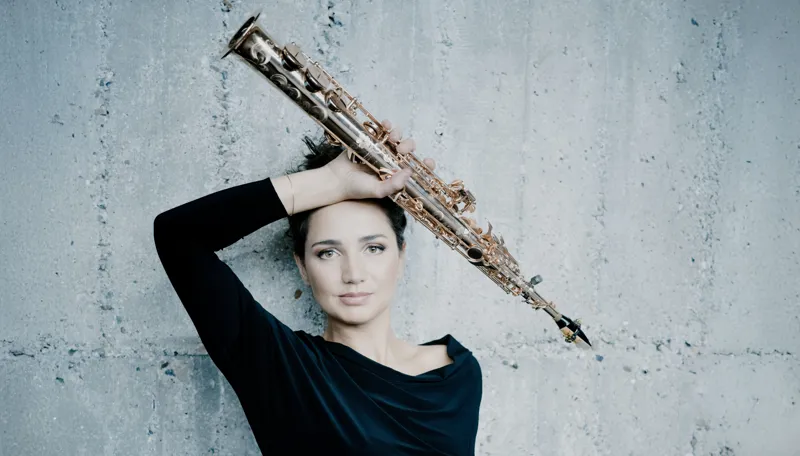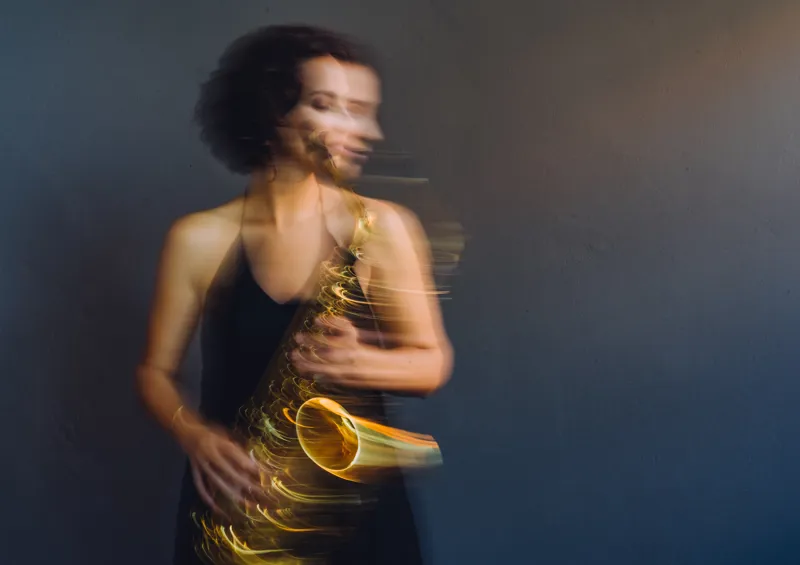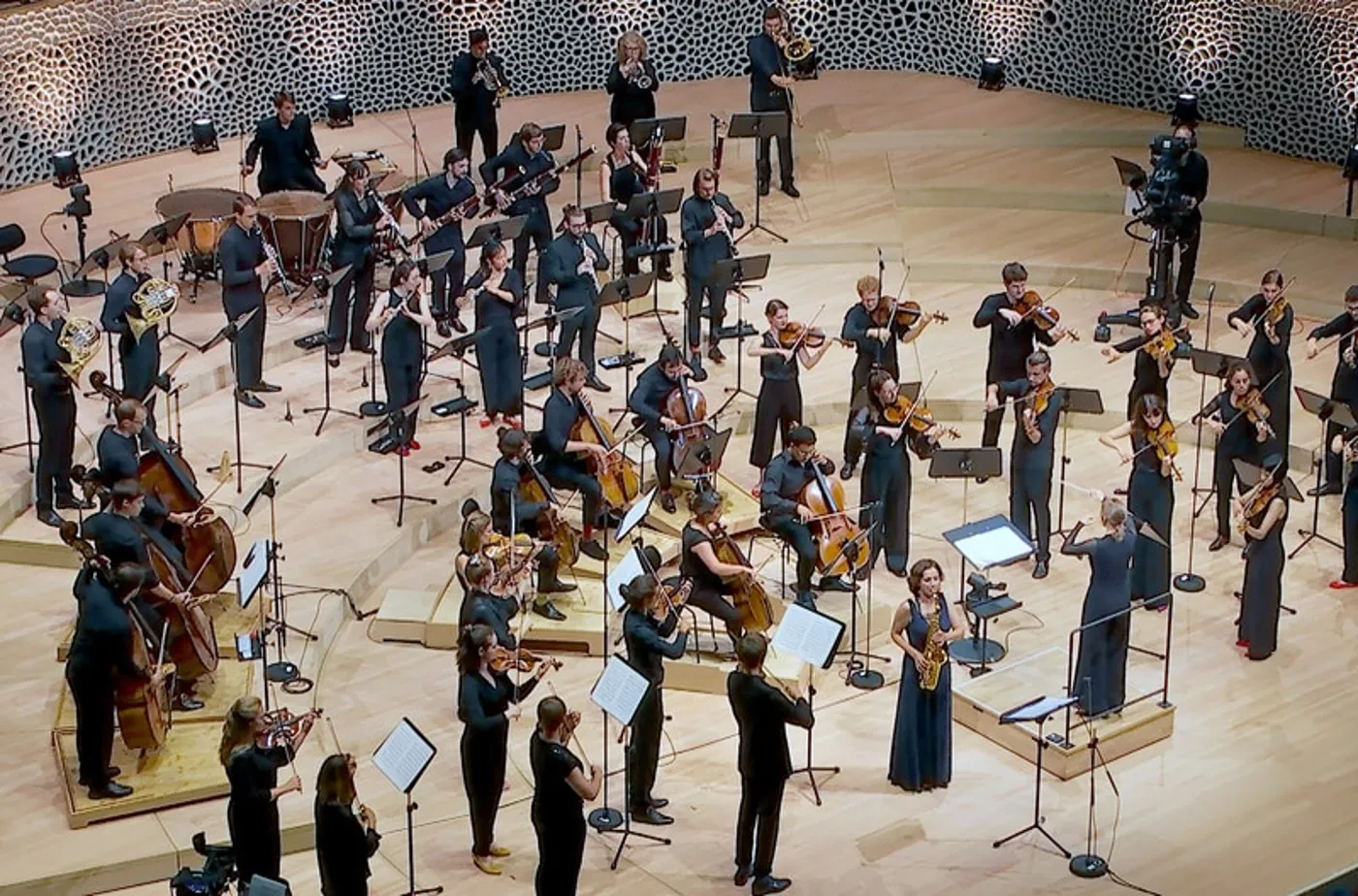
PROJECTS


Asya Fateyeva- Sopran Saxophon
Sergio Azzolini- Fagott
L´Onda Armonica
Farben des Barocks „Il Proteo“- die Verwandlung
Werke von Antonio Vivaldi, Georg Friedrich Händel, Alessandro Marcello.
Die intensive Beschäftigung mit dem Repertoire des 17. und 18. Jahrhunderts mit speziellem Augenmerk auf dem italienischen Stil und seiner Verbreitung in Europa im Zeitalter des Barock ist ein gemeinsames Ziel von Asya Fateyeva mit Fagott-Virtuosen Sergio Azzolini und dessen spielfreudigem Ensemble »L’Onda Armonica«.
Antonio Vivaldi „Il Proteo o sia il mondo al rovescio“ Konzert F-Dur RV 544 (1678-1741) für Saxophon, Fagott, Streicher und Basso Continuo
Alessandro Marcello Konzert c-moll S.Z. 799 für Saxophon, Streicher und BC
Antonio Vivaldi Konzert C-Dur RV 554 „con molti Istromenti“ für Saxophon (Orig. Oboe), Violino conc., Organo obligato, Fagott (Orig. Cello), Streicher und BC
.webp)
DANCING QUEEN
Man könnte sich jetzt weit aus dem Fenster lehnen und Parallelen suchen. Und
auch finden, sicher, wenn Wille und Fantasie gleich groß sind. Man könnte
schon begründen, warum die Musik von Jean-Philippe Rameau und von ABBA
bestens zueinander passen. Dann würde man ausholen und sagen: Sowohl
der französische Barockmeister als auch die schwedischen Pop-Ikonen waren
Superstars ihrer Zeit. Schrieben Musik, die zum Tanzen einlädt – Rameau im
Frankreich von Ludwig XV., wo man gerne tanzte, wenn auch wohl nicht so
ausgelassen wie in den Discos der 1970er zur Musik von ABBA. Ja, und war
nicht Jean-Philippe Rameau an der Orgelbank ebenso ein Autodidakt wie die
beiden ABBA-Komponisten Benny Andersson und Björn Ulvaeus?
Vergessen Sie alles, was bis hierhin geschrieben steht. Und halten Sie sich
lieber an das, was Wolfgang Katschner zur Programmkombination auf diesem
Album sagt, mit dem die Zusammenarbeit mit der Saxophonistin Asya Fateye-
va fortgesetzt werden sollte. „Unser Arrangeur und Cellist Bo Wiget,“ so der
Gründer der Lautten Compagney Berlin, „wollte gern ABBA-Songs machen
und ich habe dann Rameau vorgeschlagen, denn bei solchen Kombinationen
ist es immer wichtig, dass die Partei neben der Popmusik einen starken Eigen-
wert hat, und das ist bei Rameau unbedingt der Fall.“ So einfach kann es sein,
und so sinnvoll noch dazu. Und wenn man dennoch daran festhalten will, die
Fusion zu begründen, sollte man weniger faktenbasiert vorgehen, sondern
mehr auf die Musik hörend: „Rameau ist sehr artifiziell, aber auch exaltiert
und avantgardistisch – dadurch gibt es immer wieder gute Verbindungen und
Brücken zu ABBA“, hat der Lautenist Katschner erkannt.
DANCING QUEEN
One could go out on a limb and look for parallels – and with an equal dose
of will and imagination certainly find them. One could justify why the mu-
sic of Jean-Philippe Rameau and that of ABBA are a perfect match. One
could even go further and say that both the French Baroque master and the
Swedish pop icons were superstars of their time. Rameau wrote music that
invited people to dance – in Louis XV’s France, where people liked to dance,
even if not as exuberantly as people did to ABBA’s music in discos during the
1970s. And indeed, wasn’t Jean-Philippe Rameau self-taught as an organist
just as the two ABBA members Benny Andersson and Björn Ulvaeus were as
composers?
Forget everything written thus far. Instead, focus on what Wolfgang Katsch-
ner says about the particular program on this album, which continues the
collaboration with saxophonist Asya Fateyeva. According to the founder of
the Lautten Compagney Berlin, “our arranger and cellist Bo Wiget wanted to
do ABBA songs, and then I suggested Rameau, because in such intances it is
always important to have something of a strong intrinsic value alongside pop
music, and that is absolutely the case with Rameau.” It can be as simple and
as logical as that. And if one still insists on justifying this fusion, one should
worry less about facts and instead pay more attention to the music. As lute-
nist Katschner points out: “Rameau is very artificial, but he is also sublime
and avant-garde – meaning that one can always establish good connections
and links to ABBA.”
REPERTOIRE
Asya Fateyeva's wide-ranging repertoire, of which the list below is just an excerpt, crosses centuries and continents.
France/Switzerland
Claude Debussy: Rhapsodie Mauresque (1903)
Florent Schmitt: Legende Op. 66 (1918)
Jacques Ibert: Concertino da Camera(1935)
Darius Milhaud: Scaramouche (1937)
Frank Martin: Ballade for Alto saxophone (1938)
Henri Tomasi: Saxophone Concerto (1949)
U.K.
Harrison Birthwistle: Panic (1996)
Edward Gregson: Concerto (2004)
James McMillan: Saxophone Concerto (2017)
Central Europe
Erwin Schulhoff: Hot-Sonate (1930)
Péter Eötvös: Focus (2022)
Scandinavian sounds
Esa-Pekka Salonen: Concerto (... auf den ersten Blick und ohne zu wissen...) (1980)
Anders Koppel: Saxophone Concerto No. 1, No. 2 (2003)
Kalevi Aho: Saxophone Concerto (2014)
U.S.A.
John Williams: Escapades (2002)
John Adams: Saxophone Concerto (2013)
South
Luciano Berio: Chemins IV (1975) Recit Chemins VII
Heitor Villa-Lobos: Fantasia (1980)
Jean-Denis Michat: Shams (2010)
Japanese
Takashi Yoshimatsu: Cyber-bird Concerto Op.59 (1994)
Toshio Hosokawa: Saxophone Concerto (1998)
Jazz Influence
Nikolai Kapustin: Saxophone Concerto Op. 50 (1978)
Andrei Eshpai: Saxophone Concerto (1985)
John Psathas: Zahara (2005)
Ladies
Fernande Decruck: Sonate en Ut # (1943)
Paule Maurice: Tableaux de Provence (1948)
Outi Tarkiainen: Saivo (2016)
Saxophone and Chamber Orchestra
Alexander Glasunov: Saxophone Concerto Op. 109 (1934)
Lars-Erik Larsson: Concerto (1934)
Some Baroque, Classical and Romantic transcriptions
J. S. Bach (1685-1750): Concerto in G Minor BWV 1056r
J. S. Bach (1685-1750): Concerto in A Minor BWV 1041
J. S. Bach (1685-1750): Double concerto in C Minor BWV 1060
Antonio Vivaldi (1678-1741): Concerto in C Major RV 446
Alessandro Marcello (1673-1747): Concerto in C minor
Domenico Cimarosa (1749-1801): Concerto in C Major
W. A. Mozart (1756-1791): Concerto in C Major KV 314
W. A. Mozart (1756-1791): Concerto in A Major KV 622
Vincenzo Bellini (1801-1835): Concerto in E-flat Major
Johannes Brahms (1833-1897): Sonatas Op. 120 No. 1 & No. 2 Version for Saxophone and Orchestra
For a full repertoire list please contact juliane.scotney@impresariat-simmenauer.de.
REPERTOIRE
Asya Fateyeva's wide-ranging repertoire, of which the list below is just an excerpt, crosses centuries and continents.
France/Switzerland
Claude Debussy: Rhapsodie Mauresque (1903)
Florent Schmitt: Legende Op. 66 (1918)
Jacques Ibert: Concertino da Camera(1935)
Darius Milhaud: Scaramouche (1937)
Frank Martin: Ballade for Alto saxophone (1938)
Henri Tomasi: Saxophone Concerto (1949)
U.K.
Harrison Birthwistle: Panic (1996)
Edward Gregson: Concerto (2004)
James McMillan: Saxophone Concerto (2017)
Central Europe
Erwin Schulhoff: Hot-Sonate (1930)
Péter Eötvös: Focus (2022)
Scandinavian sounds
Esa-Pekka Salonen: Concerto (... auf den ersten Blick und ohne zu wissen...) (1980)
Anders Koppel: Saxophone Concerto No. 1, No. 2 (2003)
Kalevi Aho: Saxophone Concerto (2014)
U.S.A.
John Williams: Escapades (2002)
John Adams: Saxophone Concerto (2013)
South
Luciano Berio: Chemins IV (1975) Recit Chemins VII
Heitor Villa-Lobos: Fantasia (1980)
Jean-Denis Michat: Shams (2010)
Japanese
Takashi Yoshimatsu: Cyber-bird Concerto Op.59 (1994)
Toshio Hosokawa: Saxophone Concerto (1998)
Jazz Influence
Nikolai Kapustin: Saxophone Concerto Op. 50 (1978)
Andrei Eshpai: Saxophone Concerto (1985)
John Psathas: Zahara (2005)
Ladies
Fernande Decruck: Sonate en Ut # (1943)
Paule Maurice: Tableaux de Provence (1948)
Outi Tarkiainen: Saivo (2016)
Saxophone and Chamber Orchestra
Alexander Glasunov: Saxophone Concerto Op. 109 (1934)
Lars-Erik Larsson: Concerto (1934)
Some Baroque, Classical and Romantic transcriptions
J. S. Bach (1685-1750): Concerto in G Minor BWV 1056r
J. S. Bach (1685-1750): Concerto in A Minor BWV 1041
J. S. Bach (1685-1750): Double concerto in C Minor BWV 1060
Antonio Vivaldi (1678-1741): Concerto in C Major RV 446
Alessandro Marcello (1673-1747): Concerto in C minor
Domenico Cimarosa (1749-1801): Concerto in C Major
W. A. Mozart (1756-1791): Concerto in C Major KV 314
W. A. Mozart (1756-1791): Concerto in A Major KV 622
Vincenzo Bellini (1801-1835): Concerto in E-flat Major
Johannes Brahms (1833-1897): Sonatas Op. 120 No. 1 & No. 2 Version for Saxophone and Orchestra
For a full repertoire list please contact juliane.scotney@impresariat-simmenauer.de.
To the muse!
Ein Crossover-Projekt mit mittelalterlicher Musik
Asya Fateyeva - Saxophone
Matthias Loibner - Drehleier
Bo Wiget – Cello, Arrangements
Emil Kuyumcuyan - Vibraphon, Darabuka
Im 12. und 13. Jahrhundert entwickelte sich in Okzitanien (im Gebiet der heutigen Provence) die erste große Form des europäischen weltlichen Kunstliedes. Tausende von Gedichten schufen diese Troubadours und Troubairitz, die an den Höfen singend vorgetragen wurden. Beeinflusst von der Maurischen Hochkultur, die in der Zeit auf der Iberischen Halbinsel vorherrschte, entstanden kunstvolle Reim-, Gedicht- und Liedformen, welche u.a. mannigfaltige Spielarten der Liebe besingen. Diese wunderschönen Melodien – knapp 400 sind in rudimentärer Notenschrift überliefert – sind wie geschaffen dafür, sie in neue Gestalt zu bringen.
Das Quartett To the muse! um die Saxophonistin Asya Fateyeva verleiht den alten Weisen eine aktuelle Schönheit. Die außergewöhnliche Besetzung mit Saxophon, Drehleier, Cello, Vibraphon und anderer Perkussion gepaart mit der Spielfreude, großer Virtuosität und stilistischen Vielfalt führt zu neuen Hörerlebnissen. Mal klingt es ganz klassisch, dann wieder wie improvisiert, plötzlich gesellt sich ein arabischer Klang dazu, ganze imaginäre Klanglandschaften ziehen vorüber. Und stets weht eine süße Wehmut vergangener Zeit um die fast 900jährigen Lieder.
Based on original compositions and closely crossed with the dramatic and musical meaning of folk music Asya Fateyeva and Evelina Petrova create wide field for experimentation, broadening of imagination and focusing on the creation of sounding pictures inspiring by traditional music and storytelling.
Jonny
Ein Album, das zwischen tanzbaren Großstadt-Rhythmen, kulturpolitischer Verfemung und musikalischem Pioniergeist schwebt. Inspiriert von Ernst Kreneks Oper Jonny spielt auf, fängt es den Geist der 1920er Jahre ein und reflektiert die kulturellen Nuancen dieser Ära. Der auf dem Cover abgebildete Saxophonist symbolisiert die exotische und selbstreflektierende Modernität des Werks.
Asya Fateyeva untersucht, wie verschiedene Komponisten – wie Krenek, Schulhoff und Weill – das Saxophon sowohl als Medium als auch als Stimme des Zeitgeistes nutzen, um Themen von Bitterkeit und Ambivalenz gegenüber Leben und Tod auszudrücken.
Ihr Kammermusikensemble umfasst die Geiger Emma Yoon und Florian Donderer, die Bratschistin Yuko Hara, die Cellistin Tanja Tetzlaff, den Pianisten Stepan Simonian und die Klarinettistin Shirley Brill. Fateyeva hebt die intime Balance der Rollen in der Kammermusik hervor, in der jeder Musiker eine wichtige Rolle im kollektiven Erlebnis spielt.
Mit Jonny möchte sie das Saxophon als festen Bestandteil der klassischen Musik ins Rampenlicht rücken und einen Moment beleuchten, in dem dieses Instrument kurz davor war, in den etablierten Kanon aufgenommen zu werden.
Jonny
Ein Album zwischen tanzbaren Großstadtrhythmen, kulturpolitischer Verfemung und musikalischem Pioniergeist. Namensgebend für Asya Fateyevas Album Jonny ist Ernst Kreneks Zeit- und Jazzoper 'Jonny spielt auf'. Ein Werk, in welchem sich der Zwanzigerjahre-Zeitgeist verdichtet und dessen Entstehungs- und Aufführungsgeschichte die kulturgeschichtlichen Besonderheiten dieser Zeit spiegelt. Der von Arthur Stadler für das Titelbild des Klavierauszugs illustrierte farbige Saxophonist war Ausdruck der exotischen und gleichzeitig selbstreflektierenden Modernität des Werks. Die 421 Aufführungen in 45 verschiedenen Städten innerhalb der ersten Saison einerseits und die Nutzung der Darstellung des Saxophonisten auf dem Plakat der Ausstellung Entartete Musik von 1938 andererseits verdeutlichen die herausragende Rolle des Werks. Doch nicht nur Ernst Krenek widmet sich Asya Fateyeva: „Mich reizt […] besonders, wie unterschiedlich die Komponisten die Musik als jeweils eigene Sprache und Weltanschauung benutzen. Fast hat man das Gefühl, dass zwischen ihnen doch ein paar Jahrhunderte liegen müssen. Bei Adolf Busch, Paul Hindemith und Anton Webern tritt das Saxophon als Medium auf, quasi als klangliches Mittel zum Zweck. Erwin Schulhoff, Kurt Weill und Ernst Krenek verwenden es besonders als Ausdruck des Zeitgeistes und als Sprachrohr der Bitterkeit, des Sarkasmus und ambivalenten Verhältnisses zum Leben und Tod in den 1920er Jahren.“ Ihre kammermusikalischen Partners in Crime sind an der Geige Emma Yoon und Florian Donderer, Yuko Hara an der Bratsche, die Cellistin Tanja Tetzlaff, Stepan Simonian am Klavier und Shirley Brill an der Klarinette. „Das Tolle an einer Kammermusikaufnahme ist, dass es sehr intim ist. Wir sind alle im Gleichgewicht, die Aufgaben sind gleichmäßig verteilt. Es ist nicht so, dass ich solistisch unterwegs bin und es eine Begleitung gibt. Jeder Musiker und jede Persönlichkeit sind dadurch sehr wichtig.“ Man merkt dieses konzerterprobte Miteinander, den Dialog und das Interesse an den unterschiedlichen musikalischen Ausprägungen der Zeit. „Es ist eine Art Panorama – ich finde es sehr schön, dass man so ein Zeitfenster öffnet und sieht, wie mutig die Menschen waren, in dieser Zeit neue Wege zu gehen“, so Florian Donderer. „Das Ungewöhnliche ist das Saxophon in der Kammermusik. Das Saxophon ist nach wie vor nicht so richtig präsent und vielleicht auch nicht immer ganz ernstgenommen…“ Schon seit Langem sieht es Asya Fateyeva als ihre Mission an, auf das Saxophon in der klassischen Musik aufmerksam zu machen. Mit Jonny wirft sie einen Blick auf den historischen Moment, an welchem ihr Instrument kurz davor gewesen ist, sich in den etablierten Instrumenten-Kanon einzureihen.

Marton Illés Sopra l´acque ..
Rehearsals for the World Premiere at SHMF Summer 2024
NDR Vokalensemble
Klaas Stok
Marton Illés Sopra l´acque ..
Rehearsals for the World Premiere at SHMF Summer 2024
NDR Vokalensemble
Klaas Stok
Asya Fateyeva – Saxophon
Andreas Borregaard – Akkordeon
Eckart Runge – Violoncello
Ins musikalische Zentrum dieser Begegnung haben Fateyeva, Borregaard und Runge eine eigene Bearbeitung der berühmten Goldberg-Variationen BWV 988 von J.S. Bach gestellt. Dieses monumentale Werk von dreißig Charaktervariationen über eine Arie und ihrer harmonischen Basslinie, vom Schöpfer ursprünglich in ironischem Understatement als ‚Clavierübung‘ betitelt, ist ein kunstvoll durchgearbeitetes Kaleidoskop von Kontrapunktik, Tanzformen, barockem Groove und einem Kosmos an menschlichen Gefühlen (Affekten), die bei aller Komplexität und transzendentalen Tiefe auch den Bezug zum irdisch Lustvollen wahrt.
Die Goldberg-Variationen wurden schon häufig für verschieden Instrumentalensembles arrangiert. Die musikalische Bearbeitung von Fateyeva-Borregaard-Runge jedoch unterstreicht auf eine überraschend neue klangliche Weise die unterschiedlichen Dimensionen und Ausdruckswelten dieses epischen Werks.

Dieses schöne Programm lädt uns ein, über die faszinierende Kraft der Hoffnung nachzudenken. Es bringt Licht, gibt Kraft. Könnte es aber gefährlich sein, zu viel zu hoffen? Wie zerbrechlich es alles plötzlich werden kann, wenn man die Hoffnung verliert..
Immer wieder suchen Komponisten nach der musikalischen Übersetzung lebendiger Gefühlswelten. Im Laufe der Jahrhunderte der Entwicklung bleiben die Gefühle dieselben, nicht jedoch die Musikinstrumente. Die Kombination aus Saxophon, Barockharfe und Laute verleiht dem Programm einen neuen Klang und soll dieselben Emotionen wecken, die wir schon durch die Jahrhunderte tragen.
Die frühe Musik des 17. Jahrhunderts, bestehend aus beiden Sonaten von Giovanni Antonio Pandolfi und Arien der bekannten Komponistin Barbara Strozzi, führt uns durch verschiedene emotionale Zustände. Orazio Michi dell’Arpas „Spera mi disse amore“ und Giovanni Felice Sances „Accenti queruli“ interpretieren diese Frage auf ganz unterschiedliche Weise und das Bass-Ostinato der Passacaglia zusammen mit Improvisationen darauf ermöglichen uns eine Verbindung durch die Zeit zu schaffen.
Heutzutage brauchen wir die Hoffnung mehr denn je.
Hoffen wir also, dass die Schönheit die Welt retten kann!
This beautiful program invites us to reflect on the fascinating power of hope. It brings light and gives strength, but can it be dangerous to hope too much? How fragile can it become when we lose it?
Composers have continuously sought to translate the vivid emotional world into music. While feelings remain the same throughout the centuries, the musical instruments have evolved. The combination of saxophone, baroque harp, and lute gives the program a new sound, hoping to awaken the same emotions we have carried through the ages.
The early music of the 17th century, including sonatas by Giovanni Antonio Pandolfi and arias by the renowned female composer Barbara Strozzi, guides us through different emotional states. Orazio Michi dell’Arpa’s “Spera mi disse amore” and Giovanni Felice Sances’ “Accenti queruli” interpret this question in distinct ways, and the bass ostinato of the passacaglia, along with improvisations on it, allows us to connect across time.
In today’s world, we need hope more than ever. So let us hope that beauty can save the world!
Program:
Johann Paul von Westhoff: Imitazione delle Campane
Giovanni Antonio Pandolfi Mealli: Sonata Quarta « la Biancuccia »
Christophe Ballard: J’avois crû qu’en vous aimant
Giulio Caccini: Non ha’l ciel contanti lumi
Barbara Strozzi: Que si può fare
Lana del Rey: Hope is a dangerous thing for a woman like me to have
Thor-Harald Johnsen: Soundscapes
Giovanni Antonio Pandolfi Mealli: Sonata Seconda « la Cesta»
Orazio Michi dell’Arpa: Spera mi disse amore
Johann Philipp Krieger: Einsamkeit
Giovanni Felice Sances: Accenti queruli
Thomas Campion: never weather beaten sail
John Dowland: Come, heavy sleep











